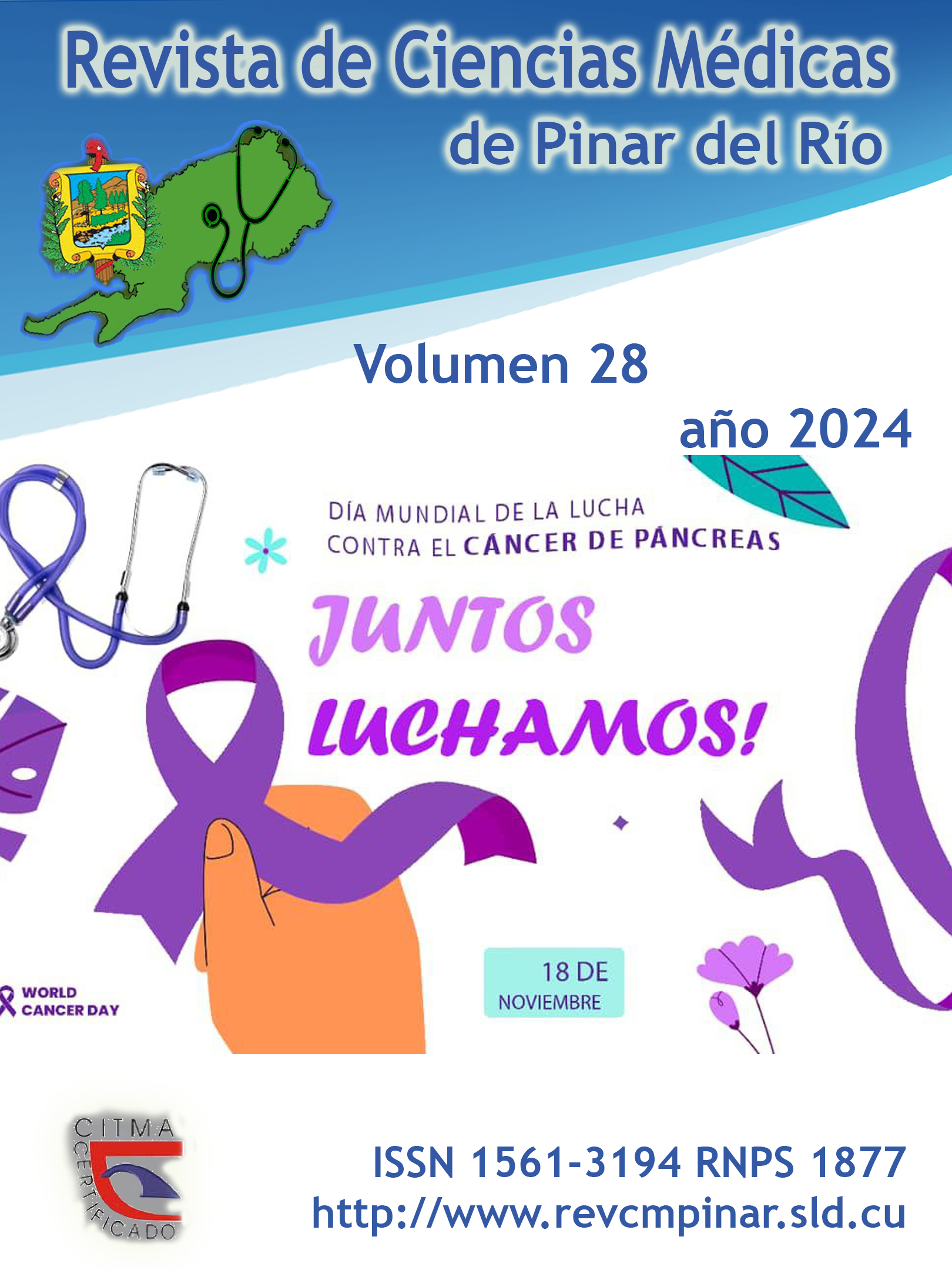Design of a Computer Application for the Management of Medical Records. Nursing Home Dr. Carlos Castellanos Blanco
Keywords:
MEDICAL RECORDS, INFORMATION MANAGEMENT, SOFTWARE.Abstract
Introduction: the medical record is the most important legal document in healthcare management, systematically reflecting the biological, psychological, and social aspects of the patient. The creation of the electronic medical record at the 'Dr. Carlos Castellanos Blanco' Nursing Home benefits both the patient and the professional due to the security and confidence it provides.
Objective: to develop the architecture for managing the information of medical records at the 'Dr. Carlos Castellanos Blanco' Nursing Home in Pinar del Río.
Methods: the research is based on observation, interviews with those involved in the processes, and document review, incorporating technological innovation using Extreme Programming as the methodology for software analysis and design stages. Unified Modeling Language (UML) and StarUML are employed for artifact modeling, and Axure Rp is used to create the prototype of the computer application.
Results: it allowed the analysis, management, and decision-making in all patient entry processes related to medical records in the nursing home.
Conclusions: a prototype was developed that facilitated the evaluation of the computer application with the doctors before its implementation, ensuring its alignment with the proposed objective.
Downloads
References
1. Moreno Rodríguez MA. El método clínico. Lecturas y lecciones [Internet]. La Habana: Editorial de Ciencias Médicas; 2012 [citado 19/06/2021]. Disponible en: http://www.bvs.sld.cu/libros/el_metodoclinico_lectura_lecciones/indice_p.htm
2. Llanio Navarro R, Perdomo González G, Arús Soler E, Fernández Naranjo A, Fernández Sacasas JA, Matarama Peñate M, et al. Propedéutica Clínica y Semiología Médica. 3ra ed.t- 1 [Internet]. La Habana: Editorial de Ciencias Médicas; 2003 [citado 19/06/2021]. Disponible en: http://bvs.sld.cu/libros_texto/propedeuticatomo1/cap01_seccioni.pdf
3. Soler Romero D. Una Clínica Dental sin Papel [Tesis]. Costa Rica: Universidad Latinoamericana de Ciencia y Tecnología. Facultad de Odontología; 2011 [citado 19/06/2021]. Disponible en: https://upcommons.upc.edu/bitstream/handle/2099.1/21409/Mem%C3%B2ria.pdf?sequence=2&isAllowed=y
CháGhiglia MM. Historia clínica electrónica: herramienta para la continuidad de asistencia. RevMédUrug [Internet]. 2019 Sep [citado 13/07/2021]; 35(3): 107-23. Disponible en: http://www.scielo.edu.uy/scielo.php?script=sci_arttext&pid=S1688-03902019000300107&lng=es
4. Vaca Sierra LJ. Desarrollo de un sistema informático basado en la Historia Clínica Odontológica Única para la aplicación y evaluación en consultorios privados de las Parroquias El Sagrario y San Francisco del Cantón Ibarra [Tesis]. Ecuador: Universidad Central del Ecuador. Facultad de Odontología; 2015 [citado 19/06/2021]. Disponible en: https://www.dspace.uce.edu.ec/entities/publication/5eb415eb-56cb-4abf-ac83-9da8918dc311
5. Duque Persad KP. Software para la gestión de control de historias clínicas odontológicas [Tesis]. Venezuela: Universidad “Rafael Urdaneta”. Facultad de Ingeniería. Escuela de Computación; 2009.
6. Barzaga Sablón OS, Vélez Pincay HJJ, Nevárez Barberán JVH, Arroyo Cobeña MV. Gestión de la información y toma de decisiones en organizaciones educativas. Revista de Ciencias Sociales [Internet]. 2019 [citado 06/05/2022]; 25(2): 120-30. Disponible en: https://dialnet.unirioja.es/servlet/articulo?codigo=7025997
7. Gil Yacobazzo JE, Viega Rodríguez MJ. Historia clínica electrónica: confidencialidad y privacidad de los datos clínicos. RevMédUrug [Internet]. 2018 Dic [citado 13/07/2021]; 34(4): 102-119. Disponible en: http://www.scielo.edu.uy/scielo.php?script=sci_arttext&pid=S1688-03902018000400102&lng=es
8. Jiménez Carrillo M, Fernández Rodker J, Sastre Paz M, Alberquilla Menendez-Asenjo A. ¿Refleja la historia clínica electrónica los determinantes sociales de la salud desde Atención Primaria?. Atención Primaria [Internet]. 2021 [citado 06/05/2022]; 53(1): 36-42. Disponible en: https://www.sciencedirect.com/science/article/pii/S0212656720300408
9. Enciclopedia Libre Universal en Español. Historia clínica [Internet]. Enciclopedia Libre; 2011 [Citado 06/05/2022]. Disponible en: http://enciclopedia.us.es/index.php/Historia_cl%EDnica
10. CháGhiglia MM. Historia clínica electrónica: factores de resistencia para su uso por parte de los médicos. RevMédUrug [Internet]. 2020 [citado 06/05/2022]; 36(2): 122-43. Disponible en: http://www.scielo.edu.uy/scielo.php?script=sci_arttext&pid=S1688-03902020000200122&lng=es
Downloads
Published
How to Cite
Issue
Section
License
Authors who have publications with this journal agree to the following terms: Authors will retain their copyrights and grant the journal the right of first publication of their work, which will be publication of their work, which will be simultaneously subject to the Creative Commons Attribution License (CC-BY-NC 4.0) that allows third parties to share the work as long as its author and first publication in this journal are indicated.
Authors may adopt other non-exclusive license agreements for distribution of the published version of the work (e.g.: deposit it in an institutional telematic archive or publish it in a volume). Likewise, and according to the recommendations of the Medical Sciences Editorial (ECIMED), authors must declare in each article their contribution according to the CRediT taxonomy (contributor roles). This taxonomy includes 14 roles, which can be used to represent the tasks typically performed by contributors in scientific academic production. It should be consulted in monograph) whenever initial publication in this journal is indicated. Authors are allowed and encouraged to disseminate their work through the Internet (e.g., in institutional telematic archives or on their web page) before and during the submission process, which may produce interesting exchanges and increase citations of the published work. (See The effect of open access). https://casrai.org/credit/



